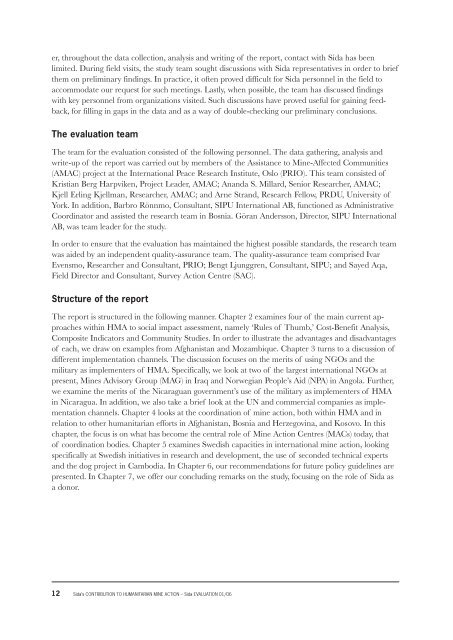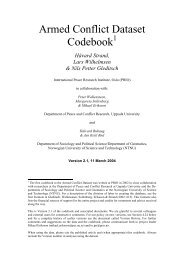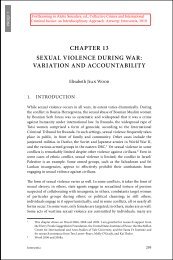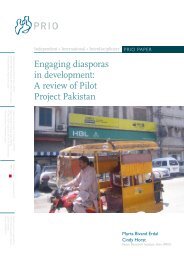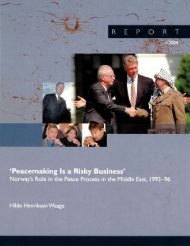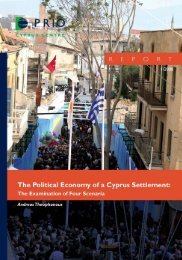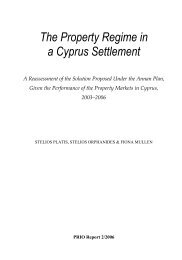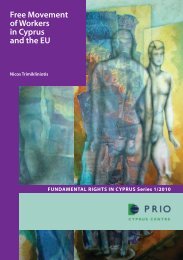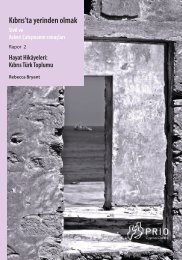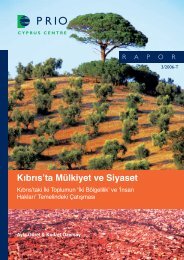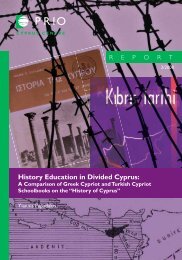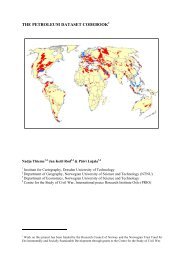er, throughout the data collection, analysis and writing of the report, contact with Sida has beenlimited. During field visits, the study team sought discussions with Sida representatives in order <strong>to</strong> briefthem on preliminary findings. In practice, it often proved difficult for Sida personnel in the field <strong>to</strong>accommodate our request for such meetings. Lastly, when possible, the team has discussed findingswith key personnel from organizations visited. Such discussions have proved useful for gaining feedback,for filling in gaps in the data and as a way of double-checking our preliminary conclusions.The evaluation teamThe team for the evaluation consisted of the following personnel. The data gathering, analysis andwrite-up of the report was carried out by members of the Assistance <strong>to</strong> <strong>Mine</strong>-Affected Communities(AMAC) project at the International Peace Research Institute, Oslo (PRIO). This team consisted ofKristian Berg Harpviken, Project Leader, AMAC; Ananda S. Millard, Senior Researcher, AMAC;Kjell Erling Kjellman, Researcher, AMAC; and Arne Strand, Research Fellow, PRDU, University ofYork. In addition, Barbro Rönnmo, Consultant, SIPU International AB, functioned as AdministrativeCoordina<strong>to</strong>r and assisted the research team in Bosnia. Göran Andersson, Direc<strong>to</strong>r, SIPU InternationalAB, was team leader for the study.In order <strong>to</strong> ensure that the evaluation has maintained the highest possible standards, the research teamwas aided by an independent quality-assurance team. The quality-assurance team comprised IvarEvensmo, Researcher and Consultant, PRIO; Bengt Ljunggren, Consultant, SIPU; and Sayed Aqa,Field Direc<strong>to</strong>r and Consultant, Survey <strong>Action</strong> Centre (SAC).Structure of the reportThe report is structured in the following manner. Chapter 2 examines four of the main current approacheswithin HMA <strong>to</strong> social impact assessment, namely ‘Rules of Thumb,’ Cost-Benefit Analysis,Composite Indica<strong>to</strong>rs and Community Studies. In order <strong>to</strong> illustrate the advantages and disadvantagesof each, we draw on examples from Afghanistan and Mozambique. Chapter 3 turns <strong>to</strong> a discussion ofdifferent implementation channels. The discussion focuses on the merits of using NGOs and themilitary as implementers of HMA. Specifically, we look at two of the largest international NGOs atpresent, <strong>Mine</strong>s Advisory Group (MAG) in Iraq and Norwegian People’s Aid (NPA) in Angola. Further,we examine the merits of the Nicaraguan government’s use of the military as implementers of HMAin Nicaragua. In addition, we also take a brief look at the UN and commercial companies as implementationchannels. Chapter 4 looks at the coordination of mine action, both within HMA and inrelation <strong>to</strong> other humanitarian efforts in Afghanistan, Bosnia and Herzegovina, and Kosovo. In thischapter, the focus is on what has become the central role of <strong>Mine</strong> <strong>Action</strong> Centres (MACs) <strong>to</strong>day, tha<strong>to</strong>f coordination bodies. Chapter 5 examines Swedish capacities in international mine action, lookingspecifically at Swedish initiatives in research and development, the use of seconded technical expertsand the dog project in Cambodia. In Chapter 6, our recommendations for future policy guidelines arepresented. In Chapter 7, we offer our concluding remarks on the study, focusing on the role of Sida asa donor.12 Sida’s CONTRIBUTION TO HUMANITARIAN MINE ACTION – Sida EVALUATION 01/06
2 Impact AssessmentThe essence of the shifts that HMA is currently undergoing lies in a reorientation from defining themine problem in terms of numbers of mines or <strong>to</strong>tal suspected area contaminated by mines <strong>to</strong> definingthe problem in terms of the impact of mines on human populations. This reorientation has inspiredthe development of different approaches <strong>to</strong> impact assessment, all drawing on insights from the widerdebate on postwar reconstruction and development. Over the past several years, Sida has becomeincreasingly interested in the issue of impact and has eagerly pursued the impact perspective with someof the agencies it has funded. At the same time, Sida’s current policy position is <strong>to</strong> prioritize mineclearance over all other aspects of HMA. Such a position serves <strong>to</strong> constrain a constructive engagementin ensuring the impact orientation of HMA programmes. Most fundamentally, a thoroughimpact assessment of any particular programme is rendered impossible, unless that programme hascollected impact data on a systematic basis.In this chapter, we will first look briefly at Sida’s policy. We will then provide a tentative definition ofimpact, before situating impact assessments in relation <strong>to</strong> stages of reconstruction, phases of projectsand level of society. We then turn <strong>to</strong> a review of four different approaches <strong>to</strong> impact assessment: Rulesof Thumb, Cost-Benefit Analysis, Composite Indica<strong>to</strong>rs and Community Studies. These approachesdiffer from each other in fundamental ways, both when it comes <strong>to</strong> the questions they generate and <strong>to</strong>the methodology applied for responding <strong>to</strong> these questions. Each approach has its own strengths andweaknesses. The challenge is <strong>to</strong> establish which one works best for a particular task or in a particularcontext and <strong>to</strong> see how the different approaches may complement each other. Finally, we will exploresome of the key challenges that an agency is faced with if it wants <strong>to</strong> make impact assessment aneffective <strong>to</strong>ol in its project-implementation practice, challenges that apply across all approaches.Sida’s roleSida has not been a visible ac<strong>to</strong>r in the process of reformulating international HMA policy <strong>to</strong> integratesensitivity <strong>to</strong> impact. At the same time, Sida has repeatedly expressed concern about the lack of evaluationsof impact in the sec<strong>to</strong>r. 1 The 1998 Afghanistan study of socio-economic impact of HMA hasbeen closely reviewed within Sida. 2 The 1997 impact study of the programme in Laos contributed <strong>to</strong>Sida’s disengagement from the programme. Concern over the scarcity of HMA impact documentationwas a key reason for why Sida in 1999 initiated a desk study on existing initiatives. 3Sida’s concern about impact has not translated in<strong>to</strong> increasing support for the development andapplication of <strong>to</strong>ols for impact assessment. The documentation of impact of any given programme isdifficult in the absence of impact data, a conclusion also reached in the Sida desk study. In Sida’s mostrecent policy formulations, there has been an explicit emphasis on demining, at the exclusion of othercomponents of HMA that include impact assessment or survey arrangements. Thus, there is as of nowan inherent contradiction between Sida’s demand that programmes have a more solid impact orientationand its lack of funding initiatives in the area.1See for example: Preliminär redogörelse för och analys av det samlade svenska stödet till olika former av minverksomheter samt underlag förpreliminär inriktning av fortsatt stöd, Sida, 28 June 2000.2<strong>Mine</strong> Clearance Planning Agency (MCPA), 1998. Socio-Economic Impact Study of <strong>Mine</strong> <strong>Action</strong> Operations Afghanistan: Interim Report.Islamabad: MACA.3Management Perspectives International, 2000. Desk Study on the State of Knowledge of the Effects of <strong>Mine</strong> <strong>Action</strong>, Draft Report,Sida, January.Sida’s CONTRIBUTION TO HUMANITARIAN MINE ACTION – Sida EVALUATION 01/06 13


